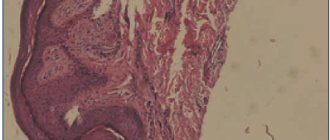Quick transition Treatment of cutaneous lupus erythematosus
Systemic lupus erythematosus is treated by a rheumatologist. During therapy with antimalarial drugs (hydroxychloroquine, chloroquine), observation by an ophthalmologist is necessary. If you suspect the development of squamous cell skin cancer against the background of discoid lupus erythematosus, consultation with an oncologist is necessary.
Lupus erythematosus rashes on the skin and/or mucous membranes can be an independent disease or a manifestation of systemic lupus erythematosus, a chronic disease associated with the formation of antibodies to components of cell nuclei. Antibodies cause damage and inflammation of various tissues, including the skin.
Forms and complications
Skin manifestations of lupus erythematosus include three groups, each including specific skin manifestations:
- acute cutaneous lupus erythematosus (localized, generalized and toxic epidermal necrolysis-like);
- subacute cutaneous lupus erythematosus (ring-shaped, papulosquamous, drug-induced, erythrodermic, poikilodermic, vesiclobulous, Rowell syndrome);
- chronic cutaneous lupus erythematosus (discoid, edematous, panniculitis, pernioid, lichenoid).
The identification of these forms is due not only to the duration of the skin disease, but also reflects the connection with systemic lupus erythematosus.
Most often, the manifestation of systemic disease is acute forms, while the discoid form is observed only in 5-15% of all cases. The longer skin manifestations exist in isolation, the lower the risk of developing a systemic form of the disease. The risk of systemic disease in the presence of cutaneous manifestations is higher in women and children.
Lupus erythematosus rashes can occur in children (antibodies are passed on to the fetus) from mothers with systemic lupus erythematosus. This form is called neonatal lupus, occurs during the first two months of a child’s life and may be the first sign of systemic lupus erythematosus in the mother.
The systemic lupus erythematosus complex may also include other changes in the skin and its appendages that are not specific exclusively to this disease.
“Unknown” lupus - answering questions
The article was prepared by rheumatologist Daria Aleksandrovna Pogonchenkova
The TV series “House” told people far from the medical world about systemic lupus erythematosus (SLE). Of course, this does not make the phenomenon of the disease any clearer: there is no accurate information about what exactly causes the disease and how lupus will manifest itself.
Below are the most frequently asked questions about systemic lupus erythematosus and their answers.
- What is SLE and how does it manifest?
The onset of lupus (or any other autoimmune disease) is extremely difficult to explain or predict. The term "autoimmunity" means that at one point, out of the blue, cells in your immune system begin to attack the body.
Such an idiopathic process can be caused by genetic changes, heredity, hormonal surges, increased levels of insolation (exposure to sunlight), or maybe absolutely nothing. Why is the disease called systemic, red, and, in fact, lupus?
The name “lupus erythematosus” was not assigned to the disease by chance. One of the identifying signs of the disease (which, by the way, does not appear in every lupus scenario) is a red rash on the face that resembles wolf bites. “Systemic” means that the disease does not occur in isolation, but affects several body systems at once. The “favorite” targets of lupus are the lungs, kidneys, heart and central nervous system.
Lupus can manifest itself in completely different ways, and that is why it is nicknamed the disease with a thousand faces: it shows itself through local symptoms of lesions, having practically no symptoms of its own.
Common symptoms of SLE:
- discoid rash, worsens after contact with the sun;
- arthritis of small joints with swelling of the hands and feet;
- pain in joints, muscles, atypical pain in the lungs, migraines
- depressed mood;
- nausea, vomiting;
- stomach upset.
Of course, a professional doctor and modern diagnostic methods make it possible to connect the symptoms together, make the correct diagnosis and begin timely treatment.
- Who is the main risk group?
The main risk group is young women of reproductive age, from 18 to 35 years old. The exact connection between female sex hormones and the onset of the disease has not been established, however, we can talk about immunological hyperreactivity due to “peaking” estrogens.
- What and how is SLE treated? Is it possible to be completely cured?
Unfortunately, there is currently no complete cure for lupus. On the other hand, timely diagnosis and appropriate treatment can guarantee long-term remission, which is an excellent result for an unpredictable autoimmune disease.
Treatment of SLE is multi-stage, combined and not at all easy. In addition to symptomatic and local medications, patients are prescribed glucocorticosteroids, initially in high doses, gradually decreasing towards remission (necessary to suppress aggressive immune reactions), TNF cytokine blockers, and non-steroidal anti-inflammatory drugs.
Long-term (and in some cases short-term) sun exposure is contraindicated for patients with systemic lupus erythematosus.
Incorrectly selected or untimely treatment can lead to the development of a wide range of dangerous complications, depending on the location and extent of the lesion.
- Are there any external manifestations?
Although it is impossible to recognize lupus at first glance, there are two signs that are the hallmark of the disease: the “lupus butterfly” and the discoid rash.
“Lupus butterfly” is a small rash on the face, symmetrically located on the cheeks on either side of the nose. It somewhat resembles the wings of a butterfly, which is why it got its name.
Discoid rash is a large focal rash that affects any area of the skin (characteristic of discoid lupus erythematosus). It worsens under direct sunlight - in some severe forms (subacute cutaneous), ulcers may form at the site of the discoid rash.
Of course, systemic lupus erythematosus is an extremely terrible and insufficiently studied disease, but modern doctors do not stop there and are developing more and more new ways to get rid of the disease and control it. For more than a year, our center has been conducting clinical trials of a new drug for the treatment of SLE. The goal is to reduce the number of exacerbations and gradually reduce the dose of hormonal drugs to the minimum for each patient. After a year of treatment, the patient has access to a new drug and observation for another 2 years.
MAKE AN APPOINTMENT WITH A RHEUMATOLOGIST
Symptoms
The skin manifestations of lupus erythematosus are diverse. A significant manifestation, almost always associated with a systemic disease, is a rash on the face, shaped like a butterfly: with wings on the cheekbones and cheeks and a body on the bridge of the nose and bridge of the nose. The rash may appear as raised or deep-lying elements of pink and bluish-red color. There is a tendency to form ring-shaped lesions covered with very dense scales that are painful when removed. In some cases, the so-called lupus erythematosus pernio is formed, in which painful bright red bluish nodules appear on the toes, hands, nose, and ears in cold weather. Damage to blood vessels is accompanied by the appearance of rashes resembling bruises; dilated vessels can be visible in the nail beds. Some patients with SLE have symptoms resembling lichen planus.
There are also severe lesions with the formation of blisters and peeling of the skin, which is more typical for the onset of a systemic disease. Changes can affect the mucous membranes, especially often the mucous membranes of the lips and oral cavity. Lupus lesions on the scalp may result in hair loss. Diffuse hair loss and hair thinning are also possible.
SLE symptoms, complaints and clinical manifestations
Redness (erythema) of the facial skin in the cheeks and nose
This is the most characteristic symptom of systemic lupus, which occurs or worsens when exposed to direct sunlight. Because of its characteristic shape, this erythema became known as “lupus butterfly.” Similar skin rashes may also occur in other areas. The skin of the fingers often changes color under the influence of cold from white to purple-bluish ( Raynaud's phenomenon ). of ulcers on the oral mucosa is possible alopecia ) and brittleness of the nail plates.
Pain and inflammation (swelling) of the joints
They occur frequently, but do not lead to the destruction of joint structures, as happens with rheumatoid arthritis. The small joints of the hands are most often affected, but arthritis of the large joints is also possible. Characteristic signs of inflammatory joint pain are morning stiffness (> 1 hour), increasing pain at rest and weakening with movement.
Pleurisy and pericarditis
A common symptom of lupus is inflammation of the pleural membranes lining the inside of the chest (pleurisy) and the heart sac (pericarditis), which can manifest as pain in the chest during breathing movements.
Kidney damage
When internal organs are involved in the process, kidney damage most often occurs, usually occurring unnoticed in SLE. Edema and a persistent increase in blood pressure are indirect signs of this serious complication.
Inflammatory changes in the nervous system. They can manifest themselves in a wide variety of ways (from headaches and psycho-emotional disorders to convulsive seizures).
Antiphospholipid syndrome. Also, with systemic lupus erythematosus, the formation of “immune agents” (antibodies) to the components of the blood coagulation system is possible. This condition is called antiphospholipid syndrome and is dangerous for the development of various thrombotic complications (vein thrombosis, heart attack, stroke). The presence of these manifestations in a patient at a young age requires the exclusion of SLE and antiphospholipid syndrome.
Nonspecific complaints. Many patients at the onset of the disease notice only nonspecific symptoms of the disease, such as general weakness, increased body temperature, weight loss, and lack of appetite.
Treatment of cutaneous lupus erythematosus
The basis of treatment is corticosteroid hormones. With this disease, they can be applied to the lesions in the form of ointments, or injected directly into the lesion of the affected skin. In severe cases, systemic corticosteroids may be prescribed. As an alternative or to enhance therapy, it is possible to apply calcineurin inhibitors to the lesions.
In cases of severe skin damage and insufficient effect of external treatment, systemic therapy is carried out using antimalarial drugs (chloroquine, hydroxychloroquine), anti-inflammatory drugs (methotrexate, mycophenolate, dapsone, azathioprine, etc.).
Features of the treatment method
The first line of treatment is topical corticosteroids and hydroxychloroquine.
To reduce the total dose and side effects of topical corticosteroids, calcineurin inhibitors are included in treatment.
During treatment with hydroxychloroquine, regular medical supervision is necessary. The condition of the retina must be monitored, since the drug can impair vision with long-term (more than 5 years) use. This side effect is uncommon, but signs of retinal damage may require discontinuation of the drug.
Intralesional administration of drugs (corticosteroid hormones) using multiple superficial injections directly into the lesion of the affected skin allows you to create a high concentration of the drug in the lesion, while reducing the risks of systemic side effects. The medicine is administered by a doctor in a dressing room to a depth of 2-3 mm. The procedure is painful, but the pain is not sharp and largely depends on the sensitivity of the patient’s receptors. To reduce pain, a thin needle is used, and an anesthetic ointment may be used.
All patients must be prescribed skin protection against ultraviolet radiation.
How is lupus erythematosus treated at the Rassvet clinic?
The dermatologist will ask you to talk about the course of the disease and the treatment that was carried out previously. The doctor will examine the skin (including the scalp) and mucous membranes. Dermatoscopy and trichoscopy can be informative. With this disease, to establish a diagnosis in most cases, a skin biopsy will be required with an additional immunofluorescence reaction.
If cutaneous lupus erythematosus is suspected, it will be necessary to discuss the possibility of systemic manifestations and assess the condition of other organs and systems of the body. Additional studies may be required to identify a systemic process (blood tests, urine tests, etc.).
Diagnosis and treatment of SLE at the Yauza Clinical Hospital
Diagnosis of systemic lupus erythematosus at the initial stage of development makes it possible to achieve rapid and stable remission of the disease and avoid the development of severe complications. In the treatment of lupus, we use drug therapy (steroidal and non-steroidal drugs, biological genetically engineered drugs), methods of extracorporeal hemocorrection.
If symptoms of SLE appear, contact rheumatologists at the Yauza Clinical Hospital. Modern treatment methods, subject to preventive measures, make it possible to maintain a state of remission for years and even decades, give birth to children, and lead an ordinary normal life.
You can see prices for services






